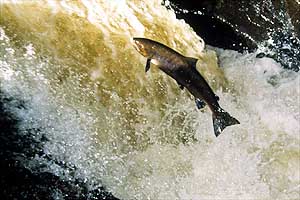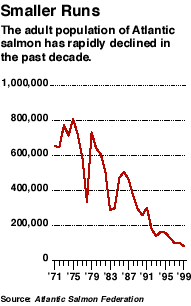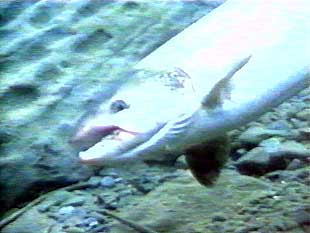By WILLIAM K. STEVENS
On a plate, where most people encounter
them, all Atlantic salmon are pretty much
alike: orange-pink fillets or steaks that melt
in the mouth when baked, broiled, grilled or
poached, or when smoked and combined
with an onion slice and cream cheese on a
bagel.
But alive, in their North Atlantic habitat, salmon today
come in two basic varieties,
farm-bred and wild. The wild
fish are sleek, silvery torpedoes that range from one side
of the ocean to the other and
whose beauty, heart and acrobatic grace have earned them
a reputation as the aristocrat
of aristocrats among game
fish.
The farm fish spend
cramped lives in ocean pens
just off the shorelines of North
America, Europe and Chile.
Comparatively short and fat,
often with fins frayed or eroded as a result
of close confinement, they are a marine
equivalent of domesticated cattle.
|

B. & C. Alexander/Photo Researchers
|
A wild Atlantic salmon on its journey upstream to spawn. Fewer are making the trip.
|
The odds are overwhelming that what a
diner encounters is a farm fish, and that fact
reflects a striking reversal: wild salmon,
once abundant, are now outnumbered by
their domesticated cousins at least 50 to 1,
and probably more.
According to recent estimates, the wild
salmon population is in what appears to be
an accelerating downward spiral; the number that are returning to spawn in their
native streams has plummeted to what
some scientists say is an all-time low.
"Something terrible is happening in the
ocean," said Bill Taylor, the president of the
Atlantic Salmon Federation.
Particularly worrisome is a plunge in key
brood stocks.
These are the older, bigger,
egg-rich fish on which the now-cloudy future of the species in
the wild mostly depends.
Historically, it is estimated, there
were 2.5 million to 5 million of
these brood salmon migrating
between ocean feeding
grounds and North American
spawning rivers.
By the mid-1970's, that figure had shrunk
to 800,000; by 1991, to about
300,000; by 1996, to a little
more than 125,000, and last
year to about 80,000.
What is going on is far bigger than the familiar near-demise of wild Atlantic salmon
in the northeastern United States.
Fewer
than 300 of these prized fish return each
year to the nine New England spawning
streams that still attract them, all in Maine,
and conservationists have recently sued to
bring them under the protection of the Endangered Species Act.
But now the decline
also appears to have accelerated throughout the North Atlantic basin at large.
Some
experts, like Dr. Carl Safina, a marine biologist with the National Audubon Society, say
that "tailspin" is not too strong a description of the situation.
Just three years ago, for instance, more
than 200,000 salmon of varying ages returned to spawn in the Miramichi River of
New Brunswick, a world-famous sport fishing stream that has been North America's
biggest single salmon producer.
From 1992
through 1996, the Miramichi averaged about
112,000 returns a year.
Then, in 1997 and
1998, the number dropped to a little more
than 40,000.
The count for 1999 is not yet in,
since much of the spawning run takes place
in the fall.
While some experts suspect there might
be a relationship between the rise of farmed
salmon and the decline of wild ones, others
doubt that this is driving the decline in the
wild.
And in fact, the general feeling among
scientists is that the cause or causes of the
wild salmon crash are unknown; it is as if
they are disappearing into some ecological
black hole.
The problem, scientists say, is not that too
few salmon are being hatched in the wild.
While many spawning rivers have been
ruined by pollution, dams and silty runoff
from farms and logged forests, experts
say that there is still enough freshwater
habitat on both sides of the Atlantic to
produce reasonable numbers of young fish.
But it appears that once in the ocean, proportionately fewer of these salmon are surviving to return to their natal rivers when it
is their turn to reproduce.
Commercial fishing that began in the
1960's has commonly been blamed for the
longer-term decline.
But fishing off North
America and Greenland, in the area where
salmon of North American origin congregate at sea, has been halted by international
agreement, and yet North American salmon
are still disappearing.
On the Miramichi,
only about 1 percent of the young, first-year
fish that go to sea return to spawn, according to the Atlantic Salmon Federation, an
international nonprofit conservation group
based in St. Andrews, New Brunswick.
Ten
to 15 years ago, 6 percent to 12 percent
returned -- at a time when large-scale commercial fisheries were taking wild salmon
wholesale.
Many things, including natural factors,
could bring on a population crash by breaking the salmon's classic life-cycle chain.
Among possible causes being investigated
are a changing climate that alters water
temperature; competition, genetic weakening and disease transmission from escaped
farm fish, and increased killing of salmon
by seals and other predators.
|

The New York Times
|
|
But "we don't actually have an answer to
what the problem is," said Dr. Malcolm
Windsor, the executive secretary of the
North Atlantic Salmon Conservation Organization, established in 1984 to execute a
conservation treaty signed by the region's
countries.
The organization is based in Edinburgh, Scotland.
The Atlantic salmon, Salmo salar, appeared in the seas tens of millions of years
ago, and for about the last 10,000 years,
since the end of the last ice age, their range
has spanned the North Atlantic.
Young, six-inch-long first-year salmon, called by the
old Anglo-Saxon name of smolts, migrate to
two main oceanic feeding areas from their
home streams in New England, eastern
Canada and Iceland, and from rivers distributed along Europe's coast from Russia's
Kola Peninsula through Scandinavia, and
the British Isles to Spain.
Those from North
America head for an open-ocean region between southwestern Greenland and northern Canada.
European fish make for waters
around the Faroe Islands, north of Scotland
(although many also swim all the way
across the ocean to Greenland.)
In their feeding grounds, they fatten up on
prey like sand eels and capelin, small smelt-like fish.
After a year of this, many return to
the rivers of their birth to spawn.
These
first-year returners, called grilse, typically
weigh about five pounds.
They are predominantly male, and the females produce relatively few eggs.
Other fish avoid spawning
as grilse, instead staying on the feeding
grounds for two or three years and earning
the full designation of salmon.
These grow
to 10 to 20 pounds or more and include many
more females, each of which carries many
more eggs than grilse do.
They are the
precious brood stock.
According to surveys taken by temporarily trapping fish as they ascend the rivers,
fisheries scientists have been able to calculate present-day populations of breeders.
The Miramichi is an important barometer.
From 1991 through 1996, according to the
salmon federation, an average of more than
31,000 brood fish ascended the river each
year.
That number dropped to 18,442 in 1997
and to a mere 9,500 in 1998.
Biologists estimate that the total population of salmon of North American origin has
dropped to fewer than 500,000 from about 1.5
million over the last 30 years.
Based on
sparser and therefore more uncertain data,
salmon of European origin are estimated to
have decreased to about 3.5 million from
about 6 million over the same period.
Estimates vary widely; these are in the mid-range.
But it seems clear, Mr. Taylor said,
that apart from exceptions like the Kola
Peninsula and Iceland, "there is not very
much good news."
While the number of salmon returning to
spawn in their native rivers is the lowest on
record, Dr. Windsor said, it is not clear
whether it is the lowest ever; records have
been kept only since 1960.
"But," he said,
"one has the feeling that things are not good
for the salmon."
Fish populations, like those of almost all
creatures, fluctuate naturally, but scientists
say that several new factors might be having an impact on wild salmon.
One, conservationists say, might be the impact of farm
fish on wild ones.
While no one has any solid
numbers, estimates of the number of
farmed Atlantic salmon off Europe, eastern
Canada, Maine, the Pacific coast of North
America and Chile run from 100 million to
200 million each year.
|

Atlantic Salmon Federation
|
|
The potential threat to wild salmon posed
by farmed ones is said to be threefold.
First,
it is argued, the farm fish are bred for
selected characteristics like growth rate
and tameness, and this could make them
less genetically diverse and so less suited
for survival in the wild.
The concern is that
when they escape and breed with wild fish,
they may reduce the ability of the offspring
to survive.
Surveys on the Magaguadavic River in
southern New Brunswick have found that
fish escaped from offshore farm pens outnumbered wild ones by up to eight to one,
and Dr. Windsor said large numbers had
escaped in Europe.
Experts say they have
no difficulty distinguishing the two varieties.
The farm fish "looks like a football as
opposed to a sleek, well-tuned muscular
fish," Mr. Taylor said.
Second, farm fish may compete with wild
ones for habitat and food. Third, diseases
and parasites are said to flourish in salmon
farm pens, and these may be transmitted to
wild fish.
Two parasites in particular, tiny
brown sea lice and a microscopic organism
called Gyrodactylus salaris, literally cover
salmon and kill them by eating their flesh.
Norway has had to poison all life in some of
its salmon rivers to get rid of sea lice.
In North America, aquaculture interests
say that while some farm fish may escape
their pens, there is no evidence of any effect
on wild salmon.
"There's no proven impact," said Dr. Brian Glebe, a salmon breeder for the aquaculture industry based in St.
Andrews, whose enterprise is overseen
jointly by conservationists, aquaculturists
and the Government.
Moreover, he said,
there are no pens anywhere near many
important salmon rivers like the Miramichi.
Mr. Taylor of the salmon federation insisted, "We're not antiaquaculture." But, he
said, the farm fish needed to be better
contained.
He also said they could be neutered so they did not pass on their genes to
wild fish, noting, "The technology exists."
Salmon farming might also be relocated to
land-based sites, Dr. Windsor said.
Despite the concern over aquaculture,
some experts believe that climatic change
may be a better candidate as the primary
driver of the decline in wild salmon.
Over
the period of the decline, the North Atlantic
has been dominated by a natural climatic
regime in which sea-surface temperatures
have been unusually warm.
The North Atlantic seas alternate over decades between
generally cooler and warmer states.
In the
warmer phase, Dr. Windsor said, colder
water from melting ice in Greenland may
cause the temperature in the oceanic salmon feeding grounds to drop below levels that
salmon can tolerate.
Some scientists believe that a general
warming of the atmosphere may have
brought about changes in atmospheric circulation that make the warmer phase of the
North Atlantic temperature oscillation appear more frequently, but this has not been
established.
Another possibility is that salmon predators like seabirds and seals have increased.
Gray seals in the salmon region are indeed
increasing by about 8 percent a year, Dr.
Windsor said.
Why? "Brigitte Bardot," he
answered.
Miss Bardot, a former actress
from France, is a leading animal-rights
advocate who has strongly opposed the
hunting of seals.
In an effort to solve the salmon mystery,
scientists have begun attaching tiny radio
transmitters to smolts migrating out of
their birth rivers.
By tracking them, they
hope to learn their fate.
In the end, Dr. Windsor said, that fate
may well turn out to have been shaped in
one way or another by human activity.
With
salmon and people, he said, "my guess is
that the two of us don't go together awfully
well."
Related Sites
These sites are not part of The New York Times on the Web, and The Times has no control over their content or availability.